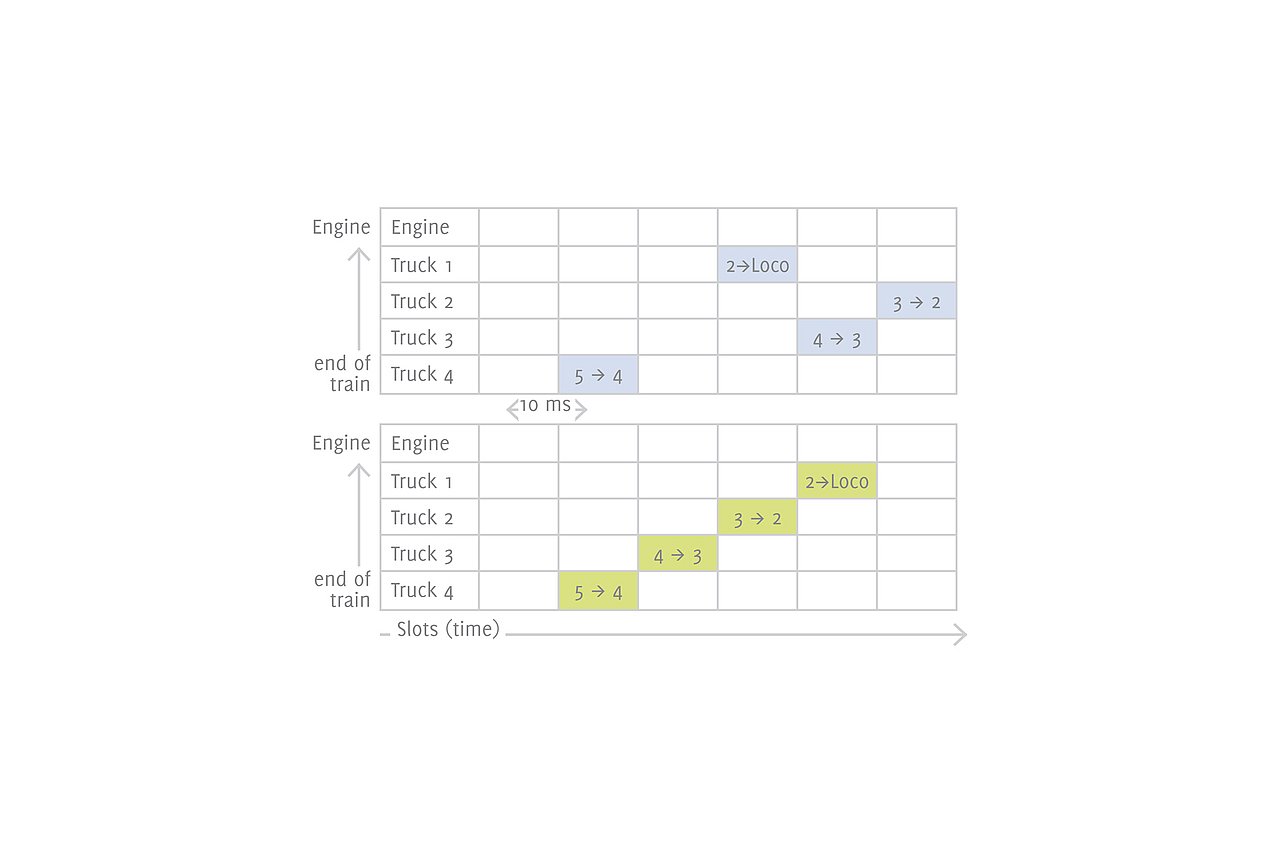Project fast realtime
Smart transport to be monitored in real time
Freight trains are dragging their feet with digitalisation
Railway trucks differ from other freight transport such as road trucks and planes in that (at present) they can only be monitored in the most rudimentary of ways using smart components. Because they carry such heavy loads and are subject to jolts and traction, rail trucks have different coupling from that used in passenger trains, which makes electrical connection from one truck to the next impossible. Because the couplings are differently constructed, it is not only the insulation of the electrics from rain and dirt which is problematic to transfer from passenger to goods trains. There is the additional complication that freight trucks are uncoupled more often and, besides, coupled and uncoupled manually. As a result, to give impulse to the innovations in rail freight which employ sensors, locators and state-monitoring, there is a need for surveillance systems that can be effectively and economically fitted onto trucks already in use, without its being necessary to reconfigure them during everyday operations.
Mobile communications used already for monitoring, but unreliable
It is already possible for trains to find out for themselves by mobile communication the data that will give them clearance for the next stage of their journey, for example. Currently, the information is gathered from the infrastructure along the line, with all that this means in terms of maintenance. The networked surveillance systems integrated into the train might in future serve to establish freight truck positions and journey times, to check the train has all its trucks, to permit automatic coupling of trucks and to monitor the load and the wheels. There are already systems in existence for the purpose, signalling data for each individual truck to an external monitoring station, in some cases also with an additional GPS receiver. However, on stretches where signal is weak or absent, central data processing will suffer accordingly. Rail services have a two-second target for message delivery, which cannot be comprehensively guaranteed when usign mobile communications.
Extending the approach: surveillance using a local wireless network
This has led the ”fast realtime“ project to adopt an additional approach and test it by constructing a demonstrator. Here the technique is to link the individual trucks wirelessly via a local sensor network and to do the monitoring internally, in the train. In this way, mobile communications are necessary only for the upstream applications on the railway network. The aim of the new system has been to monitor the operating parameters such as temperature and vibration levels for every truck on a freight train, also to check the order of the trucks and that none is missing, and to transmit all this data in real time. Such a system has to record events in trains up to 100 trucks long and transmit them to a control centre on a cloud platform in less than 2 seconds, i.e. the system requires more than 100 sensor modules, a data concentrator and a mobile communication access point in the locomotive. The control centre is responsible for many trains. This is asking a great deal, for one great problem in trains is that the metallic environment makes radio signalling less than perfect. Another problem is that it is not possible for a communication to be registered by other neighbouring sensor modules as would be the case in classic network tropologies, because the modules are in linear order truck by truck, which means that there is only one possible route for the transmission of a data packet from module to module along the train.
Solution tested on a model train to be transferred to freight trains
IMMS has created a prototype wireless network of sensors internal to a model train for a monitoring system of the kind described above. The work has involved investigating a low-maintenance, reasonably-priced, easily retrofittable system made up of available hardware and software components for wireless sensor modules. The selection and configuring of these is such that the delays in data transmission known as latency have been kept to a minimum, as is the energy consumption involved in the monitoring tasks. Funkwerk Systems GmbH, IMMS’ partner, has developed systems enabling the data assembled in the local wireless sensor network produced by IMMS to be sent by mobile communication to the central, cloud-based monitoring point.
The result is an energy-efficient monitoring system with optimal latency that is capable of forwarding the data from a freight train for processing on a cloud platform within less than two seconds – so that any alterations in state or other events can be checked and evaluated with any necessary automatic triggering of further action.
An additional communication channel between the control point and the wireless modules can be used to pre-process the data in the modules. This partial transfer of smart features into the modules themselves increases the system efficiency, in that less data has to be transmitted. All configuration messages are subjected to confirmation by the modules, which means that communication is assured.
Acronym / Name:
fast realtime / Low-latency communication in radio sensor networks and investigations on real-time behaviour of communication stacksDuration:2016 – 2018
Project website:Project website on fast realtime (in German)
Application:
Environmental monitoring and smart city applications|Automation technology and Industry 4.0Research field:Smart distributed measurement and test systems
Related content
Reference
Dr. Uwe Stöpel, Funkwerk
“The result of the collaboration is a prototype which serves to log and monitor freight train functions along the whole length and to transmit the data in real time. And not only from that: also in the general cooperation, IMMS has accelerated the progress of the project by thinking along with our requirements and being open-minded in finding solutions that matched the need and the environment.”
Towards Robust Communication-Based Object Monitoring Under Harsh Propagation Conditions
Frank Senf1. Bojana Nikolić3. Bojan Dimitrijević3. Silvia Krug1. Tino Hutschenreuther1. Hannes Toepfer2.2017 25th Telecommunication Forum (TELFOR), 21-22 November 2017, Belgrade, Serbia, pp. 1-4, DOI: doi.org/10.1109/TELFOR.2017.8249338
1IMMS Institut für Mikroelektronik- und Mechatronik-Systeme gemeinnützige GmbH, 98693 Ilmenau, Germany. 2Ilmenau University of Technology. 3University of Niš, Faculty of Electronic Engineering, Aleksandra Medvedeva 14, 18000 Niš, Serbia.Using Wireless Sensor Networks for Object Location and Monitoring
Frank Senf1. Silvia Krug1. Tino Hutschenreuther1.16. GI/ITG KuVS Fachgespräch "Sensornetze", 08. September 2017, HAW Hamburg
1IMMS Institut für Mikroelektronik- und Mechatronik-Systeme gemeinnützige GmbH, 98693 Ilmenau, Germany.
Contact
Contact
Dr.-Ing. Tino Hutschenreuther
Head of System Design
tino.hutschenreuther(at)imms.de+49 (0) 3677 874 93 40
Dr. Tino Hutschenreuther will answer your questions on our research in Smart distributed measurement and test systems and the related core topics Analysis of distributed IoT systems, Embedded AI and Real-time data processing and communications, on the lead applications Adaptive edge AI systems for industrial application and IoT systems for cooperative environmental monitoring as well as on the range of services for the development of embedded systems.
Funding
The fast-realtime project was supported by the Forschungszentrum Jülich GmbH (PtJ) with funds from the German Federal Ministry of Education and Research (BMBF) in the „Twenty20 – Partnership for Innovation“ programme under the reference 03ZZ0504J.













